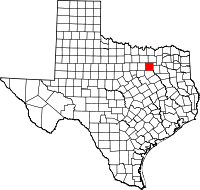Trinity Mills, Texas
USGenWeb >> TXGenWeb >> Dallas County >> Towns & Communities >> Trinity Mills, Texas
 |
|
| Latitude | 32° 58' 53" N 32.981389 |
| Longitude | 96° 55' 39" W -96.9275 |
| Elevation feet/meters |
449/137 |
| Zip Code | |
| Founded | |
| GNIS FID | 1379175 |
| TXGenWeb Site | |
| Cemeteries | |
| Library | |
| Local Genealogy Society | |
| Wikipedia | |
| Tripp | |
Trinity Mills was a small community originally settled in 1853 on land that is today part of the city of Carrollton in northwest Dallas County, Texas.
The community was on A. W. Perry's land grant and was named for a gristmill owned by him and Wade H. Witt. The actual gristmill was powered by oxen on a treadwheel and housed in a late-1840s two-story rock structure built on Farmers Creek, 2 miles (3 km) northwest of Carrollton. In 1858, a post office was established in the area which was subsequently shut-down and reopened four times before it finally closed permanently in 1915.
In 1878 the Dallas-Wichita Railroad was built through Trinity Mills and the community began to emerge as a cattle-shipping center. By 1881, Trinity Mills had a physician, 26 farmers, a druggist, and a general store. In 1884, the population of Trinity Mills had grown to 150 along with a school, 2 churches, and a Western Union telegraph office.
By 1890 the population had dwindled to fifty, and by 1915 only two stores remained in the community. By 1930 the population had dropped to 35. Eventually, the town was annexed into Carrollton and today is fully developed as part of the Dallas-Fort Worth Metroplex.
The City of Carrollton has plans to focus new development into the area near the new DART Green Line Station. The City of Carrollton and DART own over 25 acres of land at the station and plan to develop the property into the new Trinity Mills.
.... Read More Wikipedia ....
Matthew Hayes Nall
Trinity Mills was on Farmers Creek two miles northwest of Carrollton in northwest Dallas County. The site was on the original land grant of A. W. Perry. It was settled in 1853 and named for a gristmill owned by Wade H. Witt and A. W. Perry. The two-story rock structure was built in the late 1840s and was powered by oxen on a treadwheel. A local post office was established in 1858 and was discontinued and reopened four times before its termination in 1915. By 1860 James M. Kennedy had become a full partner in Trinity Mills, which also had a store.
In 1878 the Dallas-Wichita Railroad was constructed through Trinity Mills, and the community subsequently developed as a cattle-shipping center. Three years later it had a general store, a physician, a druggist, and twenty-six farmers. By 1884 the community had a population of 150, two churches, a school, and a Western Union telegraph office. Six years later Trinity Mills had a population of fifty, a nursery, a mineral-water dealer, a safe business, and a farm import business. By 1915 the community had declined to two stores, and in 1930 the population stood at thirty-five. Trinity Mills subsequently became part of Carrollton.
Bibliography: Georgia Myers Ogle, comp., Elm Fork Settlements: Farmers Branch and Carrollton (Quanah?, Texas: Nortex, 1977).
Handbook of Texas Online, Matthew Hayes Nall, “Trinity Mills, TX”




